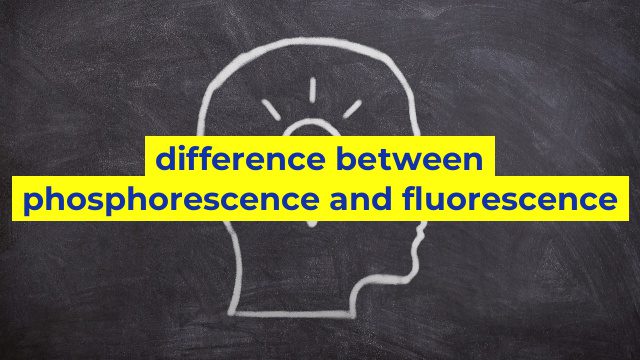Difference between Phosphorescence and Fluorescence
Phosphorescence and fluorescence are two types of luminescence, which are the emission of light from a substance that is not caused by heat. Both phenomena are used in various fields such as biotechnology, materials science, and analytical chemistry. However, there are some subtle differences between these two processes that separate them.
Definition of Phosphorescence
Phosphorescence is the process of emitting light after absorbing energy from a source. When a substance is exposed to ultraviolet, visible, or infrared light, it absorbs photons and stores the energy in its electrons. The electrons then move to an excited state that is higher in energy than their ground state. When the electrons return to their original state, they release the stored energy in the form of light, in a process known as phosphorescence. This process can continue even after the excitation source has been removed, resulting in a long-lasting glow.
Definition of Fluorescence
Fluorescence is another type of luminescence that occurs when a substance absorbs light at a specific wavelength and quickly emits light at a longer wavelength. The process occurs when photons are absorbed and transfer energy to the excited state of a molecule, which then emits a lower-energy photon. The emitted photon has a longer wavelength and lower energy than the original photon absorbed. Fluorescence can also occur as a result of energy being transferred from one molecule to another within a sample.
Differences between Phosphorescence and Fluorescence
The most significant difference between phosphorescence and fluorescence is the timescale of light emission. In fluorescence, the emission is almost instantaneous and stops when the excitation source is removed. In contrast, phosphorescence takes much longer to release its stored energy and can continue after the excitation source has been removed.
Another difference between the two is the type of energy transfer that drives the light emission. For fluorescence, energy transfer takes place within the same molecule or between different molecules within the sample. In contrast, phosphorescence involves the transfer of energy between the electrons in the molecule and other vibrational modes.
Applications of Phosphorescence and Fluorescence
Fluorescence is extensively used in bioscience and material sciences for labeling, imaging, and detection of biomolecules. It is also utilized in chromatography and analytical techniques for analyzing drugs and peptides. Alternatively, phosphorescence has found applications in security printing, lighting badges, and night vision equipment.
In conclusion, both phosphorescence and fluorescence are different kinds of luminescence that are utilized in various applications. Although they share some similarities, they differ in their emission timescale, energy transfer types, and applications. Understanding these differences is crucial in selecting the right luminescence technique for a particular application.
Table difference between phosphorescence and fluorescence
| Phosphorescence | Fluorescence | |
|---|---|---|
| Definition | Phosphorescence is a type of luminescence where the emission of light continues even after the excitation source is removed. | Fluorescence is a type of luminescence where the emission of light stops immediately after the excitation source is removed. |
| Time period | The emission of light in phosphorescence can last from a few milliseconds to several hours. | The emission of light in fluorescence lasts only as long as the excitation source is present. |
| Excitation source | Phosphorescence is excited by high-energy photons or electrons. | Fluorescence is excited by low-energy photons or electrons. |
| Energy levels | In phosphorescence, the excited state energy levels are long-lived and have low intensity. | In fluorescence, the excited state energy levels are short-lived and have high intensity. |
| Examples | The glow-in-the-dark paint is an example of phosphorescence. | The green fluorescence of a jellyfish is an example of fluorescence. |

